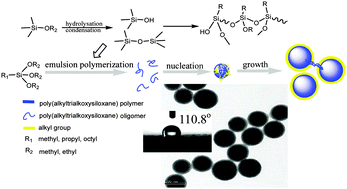Synthesis and properties of hybrid core–shell poly(alkyltrialkoxysiloxane) latex†
Abstract
We synthesized hybrid poly(alkyltrialkoxysiloxane) (PATOS) core–shell latex via emulsion polymerization under alkaline conditions using n-propyltrimethoxysilane (PTMS), methyltriethoxysilane (MTES)–PTMS and n-octylmethoxysilane (OTMS)–PTMS. We put forward the model of the core–shell structure formation mechanism in emulsion polymerization. This nucleation mechanism model and the process of these hybrid core–shell latex particles’ formation were investigated by transmission electron microscopy (TEM), scanning electron microscopy (SEM), energy dispersive X-ray spectroscopy (EDS) and dynamic laser scattering. We found that the core–shell particles were formed during chemical bond reconstruction, shrinkage and rotation in the hydrolysis and condensation reaction processes; the particles had three stages of change during emulsion polymerization; the shell of PATOS hybrid particles was an organic layer (alkyl), and their core was an inorganic layer (Si–O–Si–). The hybrid core–shell latex could be stored for more than 6 months, and the latex centrifugal stability was excellent. The polymerization coagulum content ranged between 0.09 wt% and 0.31 wt%. The weight percentages of PATOSs were above 90% when the temperature was 400 °C in a nitrogen atmosphere. The hydrophobicity of the OTMS–PTMS (1 : 4) latex (WCA ≈ 110.8°) was much more durable than that of the others due to its long alkyl chain.


 Please wait while we load your content...
Please wait while we load your content...